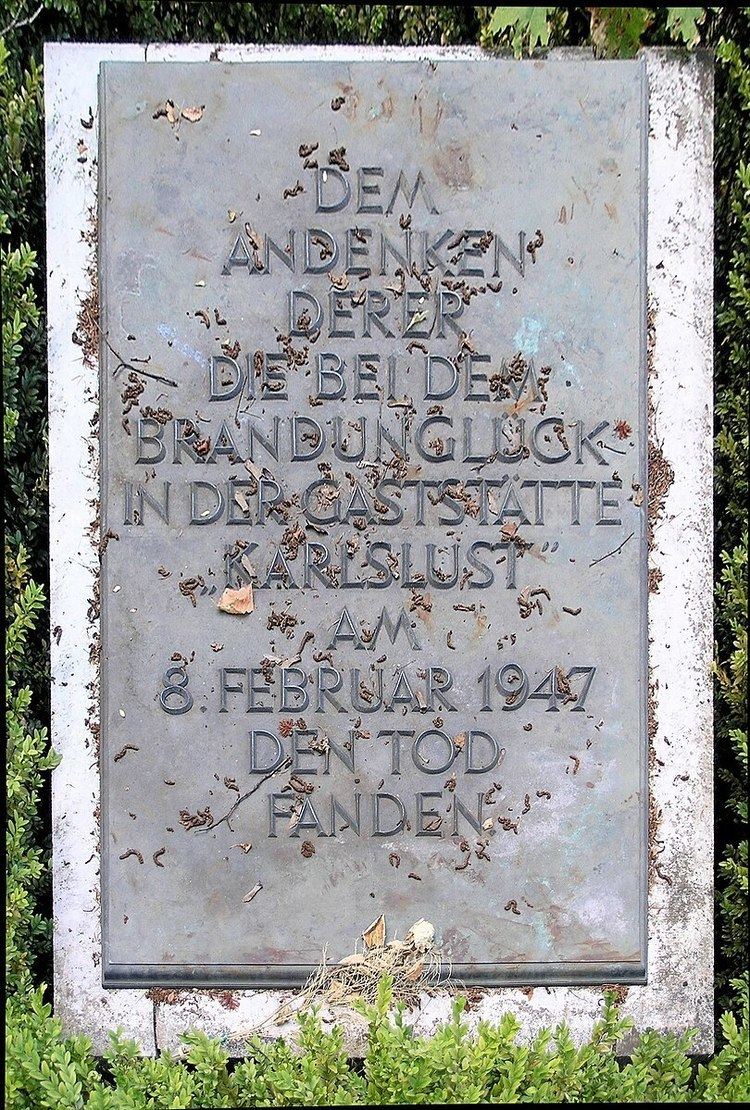Time 10:45 pm Deaths 81 | Date 8 February 1947 Non-fatal injuries 150 | |
 | ||
Also known as Loebel's Restaurant fire | ||
The Karlslust dance hall fire (also known as Loebel's Restaurant fire) occurred on 8 February 1947 in Hakenfelde, a locality of Spandau in what was then the British sector of Berlin. With its death of 80 to 88 people, it possibly marks the worst fire disaster in Germany since World War II, 88 at least in the city of Berlin. The total of death is today considered to be 81; 80 guests and the owner of the restaurant, Julius Loebel, who died while attempting to save a box filled with his money.
Contents
The fire
The Karlslust was the largest restaurant and dance hall in Spandau during the first half of the 20th century, a two storied building with ballroom and bowling alley famous for its "legendary" parties. On the evening of Saturday, 8 February 1947, the first post-war fancy-dress ball (as it was carnival time) took place. The landlord, Julius Loebel, had been granted the concession that the curfew was lifted that night (Berlin was occupied at that time). An estimated 750 to 800 (or even up to 1,000) mostly young people attended the event, among them a number of British Army staff.
Because of the very low outside temperature of −20 °C (−4 °F) or −25 °C (−13 °F), three potbelly stoves had been set up inside the Karlslust to provide heating. At around 22:45, when the party was in full swing, the wooden overhead beams of the structure caught on fire, likely (as was later determined) as a result of the intense heat of the stove pipes. As the Karlslust had been used as a prison in the last months of the war in Germany, windows were barred and doors had been walled up; a side door was frozen shut. In the ensuing rush to the only exit, several people were trampled to death. After three minutes, the entire roof of the building was on fire.
Realizing the extent of the fire, several of those who had already escaped returned to retrieve their winter clothing from the cloakroom. This behaviour was later met with incredulity by the British authorities, but can be attributed to the tight supply situation in post-war Germany, where people were living on ration stamps. Eventually, the roof of the Karlslust collapsed, burying those still inside.
Fire response
The first firefighters (of the British Army) arrived at the scene 15 minutes after the fire had broken out. Summoning firefighters was difficult at that time, because there was no standardized emergency telephone number: Each fire station had to be notified separately. The freezing temperatures and the snow-covered area hampered the firefighting efforts. In an attempt to rescue those trapped inside the collapsed building, three or six British soldiers died. A few guests of the Karlslust survived the roof collapse and could be pulled out of the debris; they had found shelter in the cellar.
German firefighters arrived at the Karlslust considerably later than their British counterparts, the bulk of them 40 minutes after having been called. This was due to the low quality of their vehicles (the engines needed some time to warm up) and the then speed limit of 40 km/h (25 mph) for civilians in Berlin (which had been imposed in order to ensure priority rights for vehicles of the World War II Allies). Also, due to bridges over the Havel river having been destroyed during the war, detours had been taken in order to get to Hakenfelde from places in Spandau as well as the rest of Berlin.
Fatalities
In the immediate aftermath of the fire, Der Spiegel reported that 88 bodies had been found, many of them burned beyond recognition, and that another 108 people were missing. 150 people were injured, 40 of which needed hospital treatment.
Later sources put the death toll to 80, 81, or 82. On 25 February 1947, 77 victims were buried at In den Kisseln cemetery, at a dedicated spot called "Loebel field", named after the landlord of the ill-fated dance hall. Until that day, all festivities and dance events in Berlin were cancelled.
Aftermath
The Magistrate of Berlin, from 1945 to 1948 the civilian government for the whole city, ordered for the delivery of cloth for 800 winter cloaks; lost ration stamps were replaced. Political parties that collected donations for the victims included the Christian Democratic Union, the Social Democratic Party and the Socialist Unity Party alike.
In order to address issues identified for having slowed down the emergency response to the fire, the speed limit for civilian vehicles was lifted on 13 March 1947, and also the general traffic priority of the allies, claimed by the allies only because of their alleged rights as winners of the war, was given up this day. and a standardized, general emergency telephone number for Berlin was re-instated on 20 October of that year. This number was the "02". Today, a high-rise building occupies the space were the Karlslust was located, at 8 Hakenfelder Straße.
